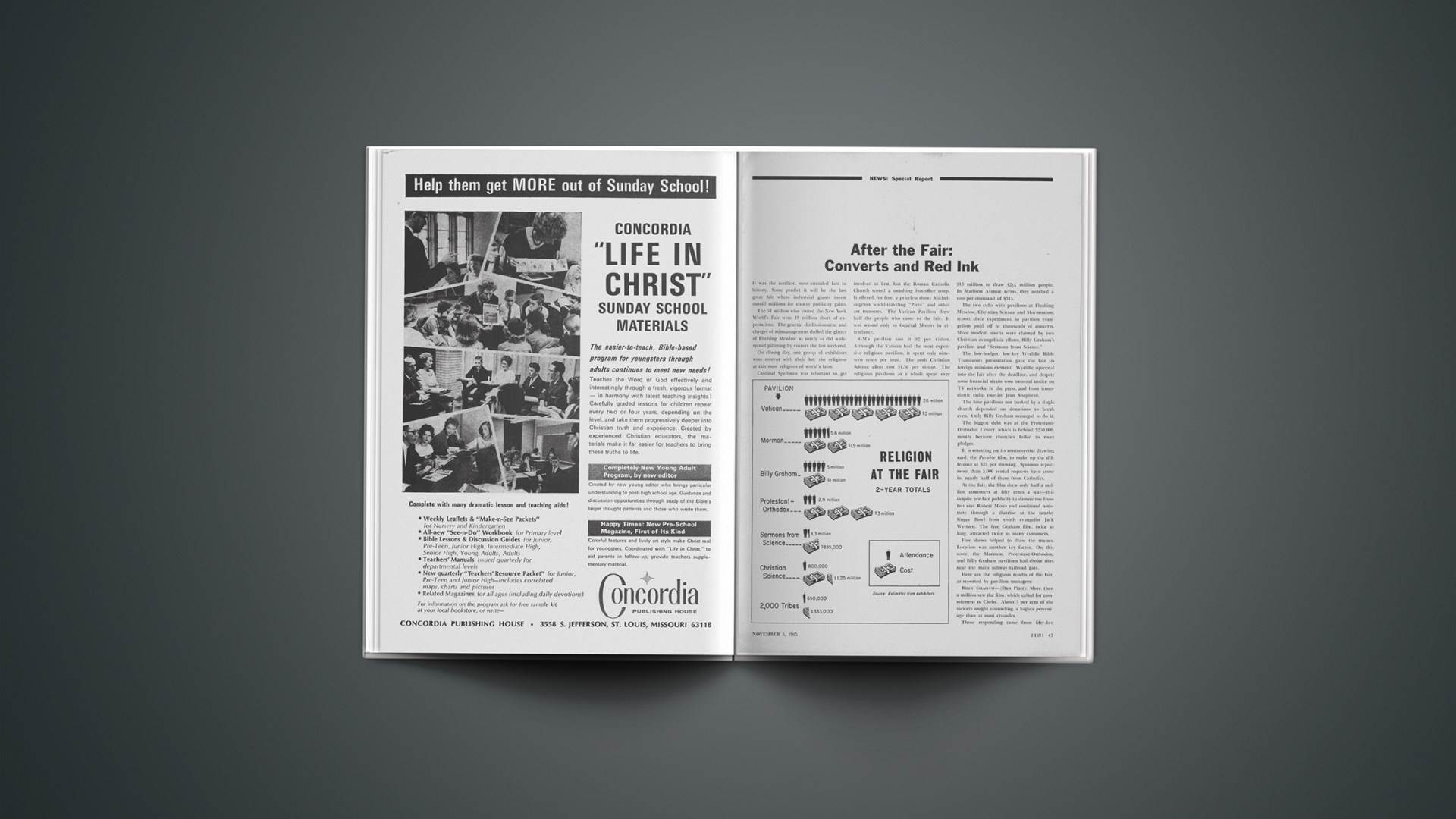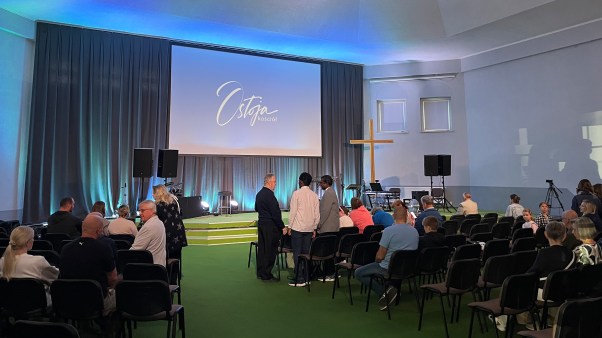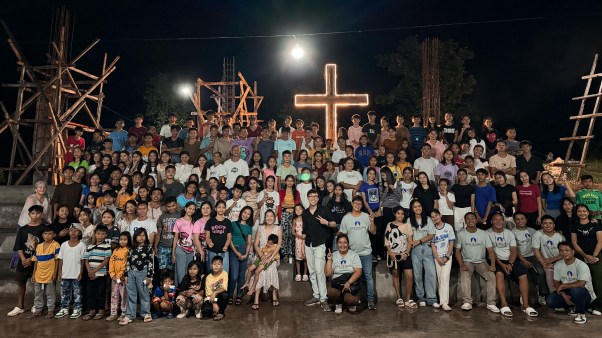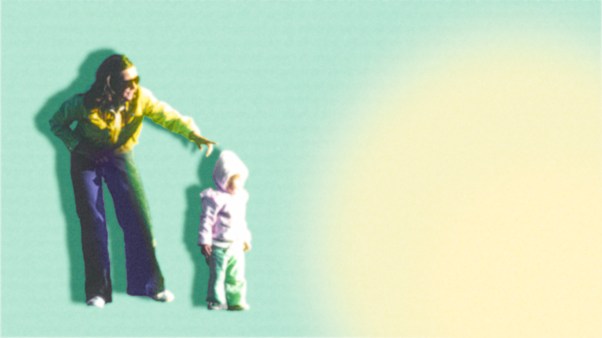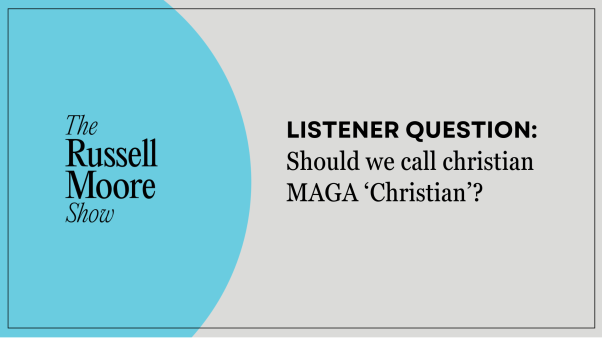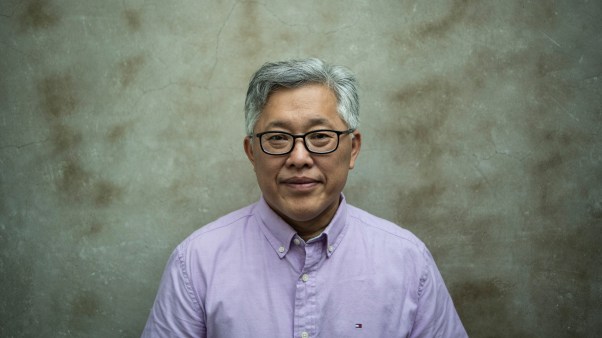It was the costliest, most-attended fair in history. Some predict it will be the last great fair where industrial giants invest untold millions for elusive publicity gains.
The 51 million who visited the New York World’s Fair were 19 million short of expectations. The general disillusionment and charges of mismanagement dulled the glitter of Flushing Meadow as surely as did widespread pilfering by visitors the last weekend.
On closing day, one group of exhibitors were content with their lot: the religions at this most religious of world’s fairs.
Cardinal Spellman was reluctant to get involved at first, but the Roman Catholic Church scored a smashing box-office coup. It offered, for free, a priceless show: Michelangelo’s world-traveling “Pieta” and other art treasures. The Vatican Pavilion drew half the people who came to the fair. It was second only to General Motors in attendance.
GM’s pavilion cost it $2 per visitor. Although the Vatican had the most expensive religious pavilion, it spent only nineteen cents per head. The posh Christian Science effort cost $1.56 per visitor. The religious pavilions as a whole spent over $13 million to draw 42¼ million people. In Madison Avenue terms, they notched a cost-per-thousand of $315.
The two cults with pavilions at Flushing Meadow, Christian Science and Mormonism, report their experiment in pavilion evangelism paid off in thousands of converts. More modest results were claimed by two Christian evangelistic efforts, Billy Graham’s pavilion and “Sermons from Science.”
The low-budget, low-key Wycliffe Bible Translators presentation gave the fair its foreign missions element. Wycliffe squeezed into the fair after the deadline, and despite some financial strain won unusual notice on TV networks, in the press, and from iconoclastic radio essayist Jean Shepherd.
The four pavilions not backed by a single church depended on donations to break even. Only Billy Graham managed to do it.
The biggest debt was at the Protestant-Orthodox Center, which is behind $250,000, mostly because churches failed to meet pledges.
It is counting on its controversial drawing card, the Parable film, to make up the difference at $35 per showing. Sponsors report more than 5,000 rental requests have come in, nearly half of them from Catholics.
At the fair, the film drew only half a million customers at fifty cents a scat—this despite pre-fair publicity in damnation from fair czar Robert Moses and continued notoriety through a diatribe at the nearby Singer Bowl from youth evangelist Jack Wyrtzen. The free Graham film, twice as long, attracted twice as many customers.
Free shows helped to draw the masses. Location was another key factor. On this score, the Mormon. Protestant-Orthodox, and Billy Graham pavilions had choice sites near the main subway-railroad gate.
Here are the religious results of the fair, as reported by pavilion managers:
BILLY GRAHAM—(Dan Piatt): More than a million saw the film, which called for commitment to Christ. About 5 per cent of the viewers sought counseling, a higher percentage than at most crusades.
Those responding came from fifty-five nations, and follow-up work was often difficult. The usual procedure is to refer the person to a nearby church, but in some cases it was hundreds of miles away. An impressed Catholic priest from Belgium told Piatt he would try to persuade his colleagues to invite Graham for another European crusade.
CHRISTIAN SCIENCE—(Admiral Edward C. Renfro): “The pavilion was one of the finest things the movement has done in many a year. Its effects have been widespread and indeterminable.” The pavilion aimed to explain Christian Science to the outsider, but also succeeded in producing new members (how many, like all membership data, is a state secret).
With the self-assurance typical of his church, Renfro said the pavilion was the “only one which dared mention God and explain who he is, what he is, and what we believe him to be.” The church recently recruited the Protestant pavilion’s Dr. G. B. Rich to praise the beauty of the Christian Science effort in a publicity film.
MORMON—(Bernard P. Brockbank): The pavilion is credited with reaping thousands of converts, more than 1,000 in the New York area alone. The full results can’t be known for years, because it will take that long for Mormon missionaries to contact the backlog of 750,000 persons Brockbank says asked for counseling.
“It changed the attitude toward the church in many parts of the country, especially the Eastern seaboard. They are more tolerant toward the Latter-Day Saints, more ready to make inquiry about us.”
PROTESTANT-ORTHODOX CENTER—(Leonard Moreland): The impact was “excellent,” the attendance higher than expected.
Moreland thought that Parable was provocative but that its symbolism went over the heads of many viewers. One professional fairgoer claims to have seen it 101 times and to have gotten something different out of it each time.
Polls showed Catholics liked the film better than Protestants and Jews liked it more than Catholics. Aside from the film, Moreland questions whether the twenty-two variegated booths at the pavilion did anything more than reinforce the constituencies of their sponsors.
SERMONS FROM SCIENCE—(W. Scott Nyborg): “We are thrilled.… The acceptance by non-Christians was amazing.”
Among the 125,000 who entered the counseling room after the Moody Institute of Science shows, 3,300 indicated decisions for Christ. While most pavilions, and the fair as a whole, drew smaller crowds the second year, “Sermons” audiences were up 35 per cent.
A large corps has contacted decision-makers, in some cases to find Mormons had already dropped by. Many nuns, intrigued by the four-step salvation presentation borrowed from Campus Crusade, asked for copies to present to their Catholic school classes.
VATICAN—(Monsignor John J. Gorman): “It was with some apprehension that the powers-that-be accepted the invitation to the fair. But I’m sure there are no regrets now. We had an opportunity to present the Church, and had good reception from the Protestant, the Jew, and the atheist.…”
WYCLIFFE 2,000 TRIBES—(Francis B. Dawson): “It was definitely worthwhile. We expect it to pay off for ten years or more. We had a chance to meet young folks and counsel them about missions. Many people hadn’t heard about Wycliffe before.” There were some heated discussions with people hostile toward missions, but many left with a different view, Dawson said.
Wycliffe, like most, ended up spending more than it expected, and the gap between cost and gifts for the pavilion is $155,000. All bills have been paid, by shifting funds; but it is the first financial bind of this size Wycliffe has ever been in, and there has been some controversy about it within the organization. The key problem: Wycliffe had planned to charge admission but soon found that if it did this, nobody would come.
Next Stop: Montreal
Flushing Meadow pavilions weren’t even down before eyes roamed to Montreal, site of EXPO ’67.
This next great superfair will feature the most ecumenical pavilion ever, a “Christian Pavilion” offered by Roman Catholics and seven Protestant groups (the latter with 60 per cent of the voting power). No role is currently planned for Orthodox churches.
The man who expects to direct it is Leonard Moreland, 64, lately the associate director of the New York fair’s Protestant-Orthodox Center.
His trim, white moustache nearly bristles in anticipation. “Roman Catholics and Protestants will promote a common purpose for the first time,” he said in his pavilion office during the twilight of Flushing. Moreland nibbled on a 7 P.M. ham sandwich that sufficed for supper. Behind him were charts tracing attendance and, scrawled on the wall, a big black “5” marking days to go.
The trouble in New York, he said, was “a rather abortive feeling of fragmentation … a cacophony of twenty-two exhibits” in contrast to other religious pavilions. Even so, he thinks of New York as a stepping-stone to Montreal, since it was a “pinnacle” in Protestant cooperative efforts.
But when it was over, he said, there was none of the “resurgence” he felt after participating in Billy Graham’s New York crusade.
Moreland predicted the Montreal program “will contain the art and culture of Christianity, and probably a motion picture.” One handicap: the classic Vatican art treasures reportedly won’t be available.
The EXPO umbrella is too wide for some groups, including the Billy Graham Association Moreland praised. It bowed out because it was prohibited from asking for commitments to Christ. But an evangelistic effort at Seattle and New York. “Sermons from Science,” is to reopen at Montreal under the chairmanship of Stanley Mackey.
Christian Science, present at the past two fairs, won’t be at EXPO. Said publicist David Sleeper, “They are presenting Christianity in one voice. We can’t say what our specific message is for mankind.”
Moreland, who is “retired” from Sperry Rand, put in seven long days a week for nearly three years, without pay, at the New York fairsite. But the day after it closed, he hopped a plane for Montreal to help get that show on the road.
Fusion And Feuds
The New York City Presbytery talked it over for an hour, then decided not to endorse John Lindsay for mayor. However, it did everything but. Its election advice, supposed to be read from 119 Presbyterian pulpits, echoed the Fusion candidate’s call for radical change at city hall and urged churches to get “involved” in the campaign.
Young Lindsay has fused Republicans and Liberals in a bold attempt to oust the entrenched Democratic regime and has attracted other ministerial backing. The Rev. Howard Moody of Judson Memorial Church (Baptist-United Church of Christ) is co-chairman of the Democrats for Lindsay movement. Leading Unitarian Dr. Donald S. Harrington said in a recent sermon that New York is a mess, that its citizens should “rise up and demand a decently governed city,” and that the only man who can change things is Lindsay.
But Lindsay could lose the election because of third-party inroads by Conservative candidate William F. Buckley, Jr. Religion became an issue when Lindsay’s Roman Catholic running mate for council president, Dr. Timothy Costello, questioned how good a Catholic Buckley is.
Close on the heels of Pope Paul’s historic trip to New York, Costello said a vote for Buckley November 2 would be anti-Catholic, against church teachings on the United Nations and on treatment of the poor and minority groups.
Costello charged Buckley’s doctrines are a “threat … to peace on earth, to the progress of the nation, the uplifting of our city, and the propagation of the social doctrine of the Catholic Church.” He spoke at Fordham University, from which he has received three degrees.
The deft-tongued Buckley, author of God and Man at Yale and editor of the National Review, replied that he would not “disgrace the Catholic Church by introducing the religions of the other candidates as issues of the campaign.” He also said he would lodge a protest with the Fair Campaign Practices Committee.
“One of the meanings of the Vatican Council is to stress the freedom within the Church, which encompasses men of many political faiths, now as before. If I am a bad Catholic, I shall be punished by Someone I fear far more than the New York Catholic voter.”
But the Catholic voter is worth fearing. He forms the largest religious bloc in a town where election tickets are famous for ethnic “balance.”
The Democratic candidate, Abraham D. Beame, is Jewish, while Lindsay is an Episcopalian. Of the moral issues of the campaign, all three hopefuls agree that crime is a pressing problem for New York.
Both Lindsay and Beame, by far the front-running candidates, have backed legalized off-track betting to help solve the city’s budget headaches. The proposal to give racetrack rakeoffs to the city instead of to bookies has been opposed consistently by the New York State Council of Churches, the Protestant Council of the City of New York, and the most prominent member of Lindsay’s party, Governor Nelson Rockefeller.
Costello’s statement was not the first Fusion bid for Catholic support. In September, Lindsay came out for limited tax assistance to Catholic and other private schools. He said that for now the aid should be carefully meted out to areas with serious overcrowding, to be used for equipment.
Paul’S Visit Revisited
The TV camera settled on a make-believe publicist phoning Pope Paul about the Yankee Stadium mass on the eve of his New York visit:
“… It would be an added attraction if there was an exhibition baseball game beforehand, between the New York Yankees and, in your honor, the St. Louis Cardinals. How does that grab you, Your Holiness?… Exactly. Sort of an ecclesiastical double-header. Now, then, we feel Your Holiness could attract an even larger number of viewers, and, incidentally, win your way into the hearts of every single American, if you would consent to just umpire a few innings of the game.… Why just think: you’d be the first umpire in the history of baseball really and truly infallible.…”
Many of the estimated three million persons who saw this satire on the Canadian Broadcasting Corporation network wondered whether anything was sacred. But the government-owned CBC’s latest quirk of courage enlivened a lackluster election campaign in Canada, where half the population is Roman Catholic.
A Presbyterian member of Parliament, Ralph Cowan, called it an “affront.” The show’s producer said the skit derided the TV industry, not Pope Paul. But the timing was unfortunate: the program followed a showing of the annual “Living Rosary” hour from Toronto, attended by 25,000 of the faithful in another instance of stadium sacrament.
South of the border, the Greek Orthodox archdiocese confirmed Religious News Service’s hunch that the Pope had met under wraps with Archbishop Iakovos in New York. The main topic: purported harrassment of Orthodox believers and Patriarch Athenagoras I in Turkey. Paul reportedly promised support.
Most of the criticism of Paul’s words in the New World focused on his U. N. assault on “artificial” birth control (see CHRISTIANITY TODAY, Oct. 22, 1965).
Blunt E. S. James, retiring editor of the Baptist Standard, was upset at all the free TV network time to cover the Yankee Stadium mass. Senator Claiborne Pell, a Protestant from predominantly Catholic Rhode Island, used the occasion of the visit to call for restudy of America’s policy against diplomatic links with Vatican City.
Cuban Exodus
A new wave of Cuban refugees began flowing into Florida last month, and religious agencies readied plans for relief and resettlement efforts. A mass exodus is expected if the U. S. government completes negotiations with Fidel Castro, who has promised to free thousands of people.
The welcome for the new refugees will not be so warm as that for the Cubans who preceded them to the American haven between 1960 and 1963. So many of that wave—perhaps 420,000—are packed into Miami and other Florida communities that they have burdened schools and hospitals and forced Negro laborers out of unskilled jobs. Even the earlier refugees fear the arrival of the new wave.
Religious leaders are pleading for “Christian compassion.” The Greater Miami Ministerial Association was the first to warn that community feelings were at a dangerous point, and to plead for acceptance of the Cubans. The cause was joined by the Greater Miami Council of Churches and Roman Catholic Bishop Coleman F. Carroll.
The council is ready with “all the practical assistance possible through resettlement, emergency relief, and social services” for the influx. Church World Service reports readiness for help in moving Cubans from Florida to other parts of the nation, and in adjustments necessary after families’ long separation.
Protestants have compiled a backlog of resettlement opportunities; they support a coordinated program for meeting emergency needs in three still-operating refugee centers and in two others that are being reactivated. The Catholic diocese has readied a downtown refugee center with food, medical treatment, and counseling. Nuns will conduct English classes.
ADON TAFT
Billy Graham Convalesces
Ailing evangelist Billy Graham, finding the road to recovery longer than expected, postponed his Houston crusade for a second time. The new dates are November 19–28.
When Graham underwent prostate surgery in early September, the crusade opening was shifted from October 8 to 15. But an infection developed, and physicians ordered him back to bed.
With the longer delay, crusade planners rescheduled a special student service to be telecast to 100 or more colleges and high schools across Texas via an educational channel. Public services will be held nightly in the new Astrodome.
From Switzerland last month came the cheerful news that Graham and his wife had become grandparents for the second time. Their oldest daughter. Virginia Tchvidijian, who is married to a Swiss, gave birth to an 8½-pound girl. The Tchvidijians, who also have a nineteen-month-old son, named the girl Virginia Bergett.
Graham also had encouraging news from London, where a major crusade is scheduled for next June. The Church of England Newspaper, which reflects evangelical views among Anglicans, conducted a poll among its readers and reported an overwhelming majority enthusiastic about the forthcoming crusade. The poll also asked, “Do you believe the Church of England is failing in its evangelistic task?” The result: 573, yes; 54, no.

